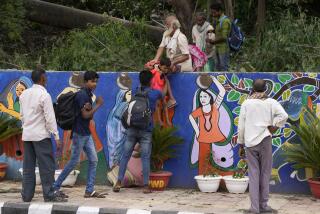Walls that talk in India
- Share via
Nawalgarh, India — TRAVELERS who stumble upon this desert town can be forgiven for feeling a bit like Dorothy waking up in Oz.
Eyes dulled by the browns and grays of the arid landscape blink in wonder at the Technicolor tones of fantastically illustrated courtyard homes. Vivid frescoes bathe every surface -- walls, window frames, doorways, arches -- in a jewel box of color, from ruby red to sapphire blue to a golden yellow worthy of any glittering brick road.
Scenes of Oz-like whimsy crowd the paintings. Hindu gods tool around in luxury cars while graceful female figures arrange themselves into the shape of an elephant. Portraits of pale-faced Englishmen, a beatific Gandhi and a cigar-puffing Jesus peer out from odd corners.
There are fanciful renditions of planes and trains by long-ago artists who had heard of such amazing contraptions but could only imagine what they looked like.
Hundreds of these beautiful but fading courtyard homes, or havelis, dot this corner of northern India, in a region called Shekhawati. Walking through the towns here is like exploring a vast open-air art gallery, the result of a century of prodigious activity by anonymous artists whose patrons spent lavishly to turn their residences into showpieces -- mainly to keep up with the neighbors.
But the heyday of the havelis came to a close more than 50 years ago. Many of these historic houses have been locked up and abandoned, their owners long gone in search of modern lifestyles in India’s big cities.
A remarkable architectural and artistic legacy now lies in danger of slipping into oblivion as the paintings themselves surrender to time, neglect and heedless destruction.
Their survival depends on whether a few activists can convince officials, residents and absentee owners -- some of whom are members of India’s wealthiest families -- that the homes are treasures worth saving.
“I don’t think they have realized that they have a very unique resource,” said Urvashi Shrivastava, an architect who is trying to catalog some of Shekhawati’s havelis before it’s too late.
“We need to raise awareness. Today we have the heritage with us, but if we don’t take care of it, in a few years it will go away.”
HAMPERING conservation attempts are the usual obstacles that confront many a worthy cause in India: bureaucratic lassitude and a lack of funds.
The effort is further complicated by the fact that the houses remain private property, often in the hands of multiple owners -- heirs of the original builder -- who cannot agree on what to do with their ancestral home or which of them ought to do it.
“Most of these havelis are 100 years old,” said Ramesh Jangid, a native of Shekhawati and one of the first activists to recognize the cultural value of what lay at his doorstep. “In these 100 years, there may be four or five generations, and the number of shareholders may be 40, 50 or 60.... So who will take charge of this repair? Who will spend the money?”
If advocates such as Jangid had their way, this entire region in Rajasthan state would be declared a protected heritage zone. Haveli owners would be compelled to maintain the properties, perhaps with government subsidies, or risk having the homes being taken over by the state. Jangid has recently met with government culture officials to discuss such ideas.
What he sees when he meanders through the dusty lanes of towns such as Nawalgarh, Dundlod and Mandawa are not just splashily decorated houses but giant canvases stamped with the religion, politics and culture of a bygone era.
The frescoes offer glimpses of the twilight of the British Raj, India’s struggle for independence, the advent of new local pastimes and inventions. The sacred (scenes from Hindu mythology) is mixed with the erotic (couplings of acrobatic skill), the extraordinary (battles on elephant-back) with the everyday (a woman admiring herself in a mirror).
“It’s a history book,” Jangid said of the homes’ social significance.
The word haveli, Persian in origin, means an enclosed space. The architecture of Shekhawati’s courtyard homes, often several stories tall, is a lovely blend of form and function incorporating principles similar to feng shui, not only to impart a spiritual sense but to maximize comfort by, for example, blocking out sunlight and drawing in breezes during the searing summer heat. Atriums kept women segregated from men and hidden from the prying eyes of strangers, following the strict code of modesty of the time.
HAVELI construction took off around the 1830s, when the merchant class here in the Rajasthani desert, known as Marwaris, began profiting handsomely from the commerce promoted by India’s British overlords. Savvy traders in rice, textiles and opium moved to burgeoning port cities such as Mumbai and Chennai and made their fortunes -- men whose names remain synonymous with Indian industry today: Mittal, Birla, Goenka, Poddar.
Their wives usually stayed behind. Perhaps out of guilt, the husbands sent back money for the construction of ever larger houses in their hometowns, and a new way to flaunt success, in exuberant style, was born.
Rajasthani royalty had been painting their palaces since the 18th century, a tradition the nouveaux riches zealously began copying.
Soon, Nawalgarh and other towns were swarming with artisans hired to lovingly detail every inch of the homes’ exteriors and courtyards.
“It was not because they were lovers of art,” Krishan Sahal, an activist who works with Jangid, said of the haveli owners. “It was because they wanted to show off their money.”
Initially, the artists used natural pigments: green from ocher, blue from indigo, yellow from the urine of cows fed on mango leaves. (That practice was stopped after it began having alarming effects on bovine health.)
Later, as trade with Europe flourished, imported synthetic dyes, such as Prussian blue, became popular, and remained the norm until the haveli craze waned in the early to mid-20th century.
The names of the artists are lost to history. But the fruit of their fertile imaginations lives on, and one of the pleasures of wandering Shekhawati is to ponder what went on in the painters’ minds as they toiled with their brushes.
Was it a cosmic joke, in one late-period fresco, to show the gods Rama and Sita, their heads shimmering in haloes of light, being chauffeured in a black stretch Rolls?
In a region where transport normally came with four legs, how strange was it to be asked by the haveli owner to portray the story of some crazy attempt at flying by a faraway pair of brothers named Wright? (Result: a man whose outstretched arms support five pairs of wings.)
In the limpid gaze of the painted British guards with their guns, or the melancholy Englishwoman fingering an accordion, is there a suggestion that they know the end is nigh for rule over the crown jewel of their empire?
When Jangid, 55, was a boy, Shekhawati’s frescoes were still vibrant with color and inspiration.
“My first dream was to be a painter,” he said. “I think it was the influence of all this art surrounding me.”
But modern times ushered in the painted havelis’ decline. By the end of the 1930s, many prosperous Marwari families had moved away.
The old abodes were left to gather dust, handed over to caretakers or let out to shopkeepers.
Thousands of frescoes have faded, peeled or crumbled away. Others have been destroyed by water seepage, defaced by thick layers of publicity posters tacked on outside walls, or demolished to make way for new development.
INSIDE one intact, still-spectacular Nawalgarh haveli, Ram Lal Saini, 79, sweeps the stone floors during the day and falls asleep at night amid a montage of scenes of the god Shiva frolicking in a river, an Englishman cradling a dog and a horse-drawn tram full of British passengers with an Indian driver and ticket taker.
Now stooped and wizened, Saini came to the house as a servant boy, paid four silver coins a month to feed the livestock and serve as the punkah-wallah, whose job was to pull the giant fan hanging from the ceiling back and forth. But his master packed up for Kolkata not long afterward, and gave him the keys.
“I’ve lived here longer than the owners have,” Saini said. “When people say, ‘Go home,’ I feel like this is it.”
Descendants of the original owner still visit from time to time, he said, but they tend to stay in hotels boasting electricity, modern plumbing and telephones, conveniences that few of the old courtyard homes were designed to have.
ONCE or twice a year, families with roots in Shekhawati return on religious pilgrimages or for ceremonial occasions such as a male child’s first haircut.
The links with their ancestral towns have become so attenuated, however, that members of the younger generation often have no clue where the family haveli is.
Most appreciative of the richly decorated residences seem to be the tourists who are coming in increasing, though still relatively small, numbers. Last year, 150,000 visitors, about a third of them foreign, traveled through the Jhunjhunu district, where most of Shekhawati’s hotels and best-known painted havelis are located.
Local officials hope to capitalize on the growing interest, and haveli enthusiasts say the extra revenue and attention could spur the preservation efforts.
But Nina Rao, a New Delhi professor who is studying the effect of tourism in the region, called on the government to play a more active role in saving the courtyard houses.
“Nobody else is going to do it,” Rao said. “This is something that should not be linked to [making] money. Today tourists are coming; tomorrow they may not.... These things are of value in and of themselves.”
Activists hope the wealthy clans who still own many of the havelis will also recognize the cultural importance of their patrimony before it is too late.
To these absentee owners, conservationists have a simple message:
There’s no place like home.
More to Read
Sign up for The Wild
We’ll help you find the best places to hike, bike and run, as well as the perfect silent spots for meditation and yoga.
You may occasionally receive promotional content from the Los Angeles Times.







